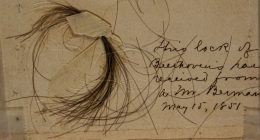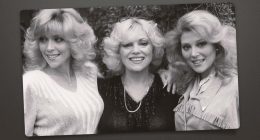
[This story contains spoilers for “Nippy,” the July 25 episode of Better Call Saul.]
It’s been nearly nine years since Michelle MacLaren directed the brutal “To’hajiilee” episode of Breaking Bad, the fourth-to-last hour of the Emmy-winning drama.
Apparently, you can’t have a preantepenultimate episode in this world without MacLaren, who returns with this week’s “Nippy.” This is MacLaren’s third Saul episode, following “Mijo” in the first season and “Breathe” in season four, and it’s part of a homestretch that welcomes a string of beloved family members back behind the camera.
After three straight episodes driven by major character deaths and decisions, “Nippy” wildly changes gears for a full installment in the black-and-white Nebraska world of Gene Takovic, the Cinnabon-managing alter ego to Bob Odenkirk’s Jimmy McGill/Saul Goodman. Jumping us forward to the events after Breaking Bad, “Nippy” continues a storyline that had previously been reserved for pre-credit openings to earlier seasons.
MacLaren hopped on the phone from Berlin, where she’s shooting an Apple TV+ pilot, to discuss getting this final chance to say goodbye to a world that has been so important, the challenges of the episode’s black-and-white aesthetic to her and her boundless enthusiasm at getting to work with “Nippy” special guest star Carol Burnett.
When last we talked, timed to “Breathe,” you mentioned that your relationship with the show is such that it’s almost an open invitation depending on schedules and whatnot. When they announced this was a final season, did you reach out to make sure you got one last shot at Saul or did they reach out?
Peter [Gould] very sweetly reached out to me over a year ago and said, “It’s gonna be the final season, would you do one?” And I said, “I would be absolutely honored to do so.” Scheduling that was a challenge, and [producer] Melissa Bernstein made it happen, because of course during that time, we were dealing with so many things, mostly COVID, and so all production dates were changing. I was on a pilot and the dates kept changing and then on Saul, for various reasons, dates kept changing. There were so many balls in the air and Melissa Bernstein and the Saul team, God bless them, worked it out and I was able to fly from Chicago to New Mexico and it was a date I did not want to miss.
I was very honored to be asked and very excited that I was able to do it.
Was there ever any point at which anybody was able to pause and be reflective enough to go, “Oh hey, Michelle directed the fourth-to-last episode of Breaking Bad, too!” Was this kismet or serendipity or something?
[Laughs] OK, the truth is that I didn’t realize that until you just said it. That’s funny.
If you’re looking for the handy term, it’s “preantepenultimate.” I looked it up.
That’s funny. You know, with Breaking Bad, I did that episode because Vince [Gilligan] wanted me to do the shoot-out, which was awesome. The thing that all of us learned very quickly on Breaking Bad and Better Call Saul is we never hand-picked our own episodes because every episode was so good in its own way that we just felt lucky to be there. But I didn’t realize that!
So this, then, would have been another episode where it was just handed to you and you didn’t get a choice?
Absolutely. We never picked. As things got later in Breaking Bad, there were certainly things that we scheduled in certain ways, but on Breaking Bad and on Saul, they have such a family of great directors — I know, because I’ve talked to other directors — that all of us felt like, “Hey, whatever we get, we’re so excited about because we’re just so lucky to be here.” I hadn’t been back on the show in a few years, and it was just like going home to a family. It was really great.
You’ve had an interesting relationship with Saul because you directed the second episode and then “Breathe” at the start of the fourth season and now “Nippy” at the end. Given that Peter and Vince have always been happy to talk about the way the show found itself as it went along, do you think you had a unique perspective on that journey from the times you were able to drop in on the family?
It was really interesting. I was thinking, “Oh it was so random that I did those three episodes,” and now I’m thinking, “Well, maybe it wasn’t so random.” The truth is that when I came to do “Nippy” and I read the episode, it called back to the other episodes very specifically in where Gene and his character are. Bob and I really talked about and referred back to specific moments that we had shot together and how they were connected to “Nippy.” So I found it really useful — for me in that moment, who had been away for a while, but who had been a fan and watched the show — that I had directed specific character arcs that were related to episode 610. That was really helpful to me in those moments talking to Bob.
What were those references or connections that you and Bob discussed?
There are certain moments in Jimmy and Gene and Saul’s story where Jimmy and Gene are becoming Saul, and there are turning points. In “Breathe,” he went back to his old ways and it was a moment where he felt that he wasn’t worthy. I think there’s a part of Gene that’s very self-sabotaging, because he doesn’t feel that he’s worth anything, other than who he is as somebody like Saul, and he’s very comfortable in those shoes. Sadly, he doesn’t feel like he’s worthy, which I think Chuck had a lot to do with, so when there was the moment where he went to steal the Hummel figurine, in that Jimmy was going back or forward to a Saul move, he was being a hustler. And in “Nippy,” he’s doing it again. He’s really good at it, and I think he’s really conflicted and he’s really torn, because there’s a part of him that really enjoys it, because he’s really good at it.
At the end of “Nippy,” when he goes and he takes the shirt and the tie off of the rack, I got tears in my eyes when we shot that, because I felt really bad for the character. I felt really heartbroken for him and I think I also felt nostalgic, too, from the old days of shooting Bob as Saul on Breaking Bad. It was such a fun, but happy-tragic moment to shoot. It made me think a lot about this character and how he became Saul Goodman and the arc of his character and those small moments that had such a big impact on his life.
So you get the script for “Nippy.” When did the Carol Burnett of it all become involved?
They said, “Will you come and do this?” They said, “We’re going to have a very exciting guest star.” They teased me and they said, “We’re not going to tell you who it is until we know for sure she’s doing it.” I was like, “OK,” not that I needed an exciting guest star to say yes. But when they did tell me it was Carol, I was like, “Oh my gosh!” I mean — she is an icon, and I was so excited to work with her. And she’s absolutely everything you want Carol Burnett to be and more. She is just a beautiful soul. She is so brilliant, so talented, so kind, so collaborative. She’s super-generous with her stories, stories that are so groundbreaking and glass ceiling-breaking and all of those things and she’s so humble about it. And she’s funny! She’s Carol Burnett, right? She’s so funny.
We were shooting in the grocery store in the beginning, and we were doing this shot where we were following her and I thought, “Oh my gosh, do I have the nerve? I’m gonna ask if she’ll do a take where she touches her ear.” I thought, “I don’t know if it’ll make it in. We’ll make it super, super subtle.” But just as a kid growing up and watching her, I was like, “I wanna ask her.” And she was so lovely and so sweet. She’s like, “Absolutely!” And I’m sure she’s probably been asked a million times to do that kind of thing, but she came on set one day and she did the Tarzan call, which was awesome! She’s super, super smart. She’s really a lovely soul and, as I was saying, so generous and kind. She was an absolute dream. I loved working with her and she’s so talented.
I interviewed her for something random back in 2016 and it was so generally cool to talk to Carol Burnett that I don’t remember a thing we spoke about. It’s not like you’re probably starstruck with everybody cool that you work with, but were you starstruck with Carol Burnett?
It’s funny, because I think the term “starstruck” can be interpreted in different ways. I was in awe with Carol, but she puts you at ease immediately. Bob had a lunch, and that’s where I first met her before we started shooting and I was so excited and so nervous — good nervous. She immediately puts you at ease and makes you feel comfortable and relaxed. So your nerves go away. So yes, I’m in awe and yes I’m starstruck, but not in a bumbling way. I found her incredibly collaborative and just a joy. But yeah, I was totally starstruck. I’m like, “Wow, it’s Carol Burnett.”
Were you able to take that step back and ponder what it was like to be doing these largely dramatic scenes with Carol Burnett and Bob Odenkirk, two of the key comedy figures of their respective generations?
I’ve had the privilege of doing straight drama now with a variety of great comedians, with Carol being at the top of that list, obviously. It’s such a joy and so fun and mind-blowing to do drama with comedians, because we’re all used to them being ha-ha funny, and I think the hardest thing to do is comedy. That’s in my humble opinion, because I’m not that funny, but I think it’s a very hard thing to do. I think that a lot of comedians can be really good dramatic actors, and there’s probably a lot of really good dramatic actors who can be great comedians, but there’s something where these comedians, they expose themselves so much by putting themselves out there being funny, so I think there’s something very raw for them when they do drama, something very real.
That scene around the kitchen table with Bob and Carol and Pat Healy [who plays cabdriver Jeff], I just loved doing that scene. Here you’ve got these comic geniuses having a conversation and having, of course, another conversation at the same time, with innuendo and looks and all that kind of stuff, and never making each other look stupid or unaware and making it work so brilliantly. That was really fun. The scene with Bob and Carol in the kitchen at the end, one of the things we wanted to make sure is that her character never looked played, she never looked like an idiot. She’s a smart, sassy, confident woman, and Gene is such a good hustler that he had to play it really well and really seriously and really genuine. That’s why he doesn’t dive in there with a bunch of hokeyness. He plays it real. He picked a dog because she’s a dog-lover. He draws her in so brilliantly, and it’s so kind and real that Carol’s character never looks like she’s an idiot. She’s a savvy, confident lady who knows how to take care of herself. That was really important to us.
These brilliant comedians have such a great way of riding that fine line and I love it. It’s one of my favorite things to do and I got to do it with the queen. She’s just the most amazing.
When it came to doing a full Gene from Omaha episode, were there concerns on your part or on Peter and Vince’s part about whether this world, which we’ve only seen in five-minute, episode-opening installments, would be able to carry a full hour without the style and rhythms feeling like a gimmick?
Peter Gould did a really interesting thing. He sat down with Paul Donachie, our cinematographer who I love and adore, and myself and it was like taking a master class. He had pulled a bunch of black-and-white clips from various movies and he really talked about what he thought the light meant in certain places and he said, “I really would love it if you guys were inspired by this and could use this in the episode.” And it really did very much inspire Paul and me, and we found moments, like where Gene steps into the light and he’s being a good guy and he steps into the darkness and he’s not being a good guy. If you look in the garage, there are moments where he comes out of the dark, and he’s in the shopping mall and he’s just pulled off a great moment with Frank [Jim O’Heir] and he’s happily walking down the hallway and as soon as he gets out of the corner from the cameras, he steps into the darkness, into the shadows.
With black-and-white, some people may think it’s easier, but it’s not. I think it’s harder, because we live in a colored world. When you look at red or blue or yellow or green in black-and-white, they have different shadings. We literally had to get a color wheel to see what color looks like in black-and-white and then design the show accordingly, from wardrobe to set design, so that we could have these different levels of darkness and light and whatever was important to the emotional beat of the story at any given moment. That was really exciting. I had never done anything like that before. Paul and I, with the production designer and the costumer, we all worked really hard on being specific about what color everybody was wearing. Patterns, too! Patterns shoot differently in black-and-white. That was fun to do. Very exciting.
What were the examples that Peter gave to you and Paul? Are we talking vintage noir? New stuff like Paper Moon?
I can’t remember now off of the top of my head, but it was a lot of vintage noir and it was really helpful. I studied film noir and what it represents in college and I loved it. It’s not that I’m an expert or anything like that, but it was really fun to look at it from that point of view. A lot of times in film noir, the bad guy’s a woman, but in this case of course it’s not, but [there’s] the understanding of light and how it’s used in black-and-white, and it was fun to play with that. Paul Donachie did an amazing job.
And the climax of the episode is the flashiest heist imaginable set in the drabbest environment imaginable. What were the challenges of finding the balance between the flash of Gene’s plan and the inherent blandness of a Midwestern mall?
My gosh. When we shot that, I haven’t laughed that hard on a film set since I shot episode two of Better Call Saul, when we did the montage of Bob as Jimmy being a lawyer and I literally cried with laughter when we shot that. This is where it helps to have these actors who are credible comedians as well, but they’re also really great dramatic actors, because they need to play it straight and real, but it’s so ridiculous what they’re doing in the moment, mixed in with the tension of, “Oh my gosh, are they going to get away with this?”
That’s something that we really found on Breaking Bad and expanded on in Better Call Saul, is that when you’re doing something that feels very real and grounded super, super tense, if you get the tiniest bit of funny in there, something that’s ridiculous, it’s hilarious. I can’t remember which episode it was of Breaking Bad, but we were screening it for a SAG event or something, and I remember we had a kind of funny beat, but people laughed hysterically at it. I realized that they laughed hysterically because they were so tense from what was happening that they wanted some release.
With Pat Healy, when we were shooting it, I turned to everybody as I was practically falling out of my chair because I was laughing so hard, and I said, “Look, is this really funny or am I just desperate for it to be funny? I think it’s really funny.” And they said, “No, it’s really funny.” I hope the audience thinks it’s really funny. I don’t know.
It’s extremely funny.
Good! I just want to tell you again that it was an incredible honor to come back and do one of the episodes the last season of Better Call Saul. I feel so privileged to be a part of the Breaking Bad/Better Call Saul family and I’m just really grateful and it was an amazing experience.
Source: Hollywood








